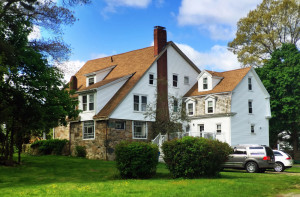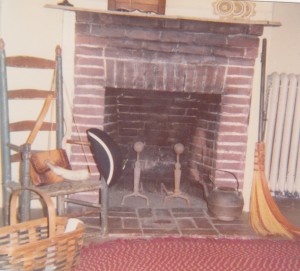True Tales from Canton’s Past: The House Within
By George T. ComeauThe Canton we know today was once the wilds of Dorchester. This area, largely inhabited by the Ponkapoag tribe, became an attractive settlement for a handful of pioneering men and women leaving the relative congestion of larger towns. The idea of buying and selling land was a purely English notion; the natives had no concept that they had the ability or the necessity to buy or sell property. The early pioneers took full advantage of the natives, and from their illegal transactions a town was born.

The historic Withington-Bird House is now tucked away near a modern subdivision on Lantern Lane. (Photo by the author)
The Massachusetts Bay Colony had passed a statute in 1633 that made all land transactions between Indians and colonists “null and void.” By 1701, the act was reenacted and anyone who participated in such transactions could be punished by fines or imprisonment. In spite of the law, our earliest settlers simply squatted on the land and the native population seemed to live in relative harmony — at least that was the case here.
One such early settler, Henry Bailey, received a lease in 1703, and it was written as to run 198 years. Bailey had been born in Sussex, England, in 1660 and had come to Massachusetts in 1690. Bailey found his way to a piece of land in what is now the area between Pleasant and upper Bolivar streets. This tract of land was just outside the boundaries of the Ponkapoag Indian Plantation and consisted of dry upland near meadows and brooks. In short, it was a perfect place to raise a family, and fairly far away from the closest neighbor.
Bailey and his wife and children lived here, likely as weavers, for about 14 years. Two years before he died at age 55, Bailey began to think about his own mortality. In a letter to a young nephew in England, he writes, “These lines are from your affectionate uncle, Henry Bailey, who is, through the goodness and mercy of God, yet living in the town of Dorchester, near Boston, in New-England; and although the Providence of God hath cast me a great way off from my native country, yet I would not forget my native land nor my relations in old England … And although the Lord hath spared my life hitherto, yet I now grow into years, and I think it time to set my house in order and to dispose of that estate which God hath given to me in this world, by will. I have therefore of late made my will; and whereas I should be very glad to see you here in New England, so for your encouragement, if you see fit to come over and so settle here with, us, I will bestow one-third part of my lands, and cattle and buildings upon you. If yourself cannot come over and settle with us, then I desire that your brother, Richard Baily, should come over and I will be helpful to him also.”
The farm that Bailey had built was near Beaver Brook and he raised cattle, horses, and swine. And on that land today are several modern houses surrounding a stately old house that is partially made of stone. Portions of the house at 3 Lantern Lane contain remnants of the original house of Henry Bailey. The story is a long and twisted tale of successive owners adapting and building upon previous generations. Yet this house is, architecturally speaking, a fascinating part of our history dating back more than 300 years. The stone portion of the house dates to the time of the Canton Viaduct (1835) and was built by Ebenezer Johnson, a housewright for Wales Withington, who was Edward Bailey’s son-in-law. It was constructed upon the house built by Edward Bailey’s son in 1756, which in turn was built on a house from his father Henry’s time before 1716. Pieces of each house are embedded within, as it was often sensible to reuse lumber than have to cut new timbers and boards.
The stone-built first story follows a five bay center entrance plan facing south to Bolivar Street, with quarried granite walls on the south, west, and east sides, with a rear shed wing on the east side that might be part of the original design. In 1871, the property was acquired by Frank M. Bird and fully purchased by 1878. The renovation that took place under Bird’s direction was extensive and magnificent.
Frank Bird was the son of Francis W. Bird, an antislavery leader, state legislator, and paper manufacturer from East Walpole. Needless to say, the Bird family had wealth and prestige, and the house in Canton reflected both. There were formal gardens, trees imported from England, and a swan pond just to the right of the entranceway leading to the house.

The master bedroom boasts a fireplace reminiscent of colonial times. (Courtesy of the Canton Historical Society)
Among the changes to the house was a west stairhall tower with an Italianate newel post in bulbous profile and a stairhall window with stained glass geometric border design. A similar geometric window was also inserted on the west wall, possibly replacing the original chimney stack. Later additions in the Queen Anne-Shingle Style include the second and third story gable roof with inset attic windows. A second phase of the remodeling ca. 1890 apparently included a rear north side addition for a dining and living room with a fireplace mantel in Colonial Revival Style by a skilled architect built into a rear stone wall, including a rear kitchen ell capped by a gambrel roof.
The house has had three addresses over the years. Originally it had frontage on Bolivar Street, and that is how the “stone house” was accessed. When Bird bought it, he built a driveway onto Pleasant Street — a far more desirable address. And today it is on Lantern Lane, a small subdivision that once comprised the main property. As you drive up Pleasant Street from Stoughton, and just passed the “roundabout” look to your left and watch for a large stone pillar. Today that pillar sits in lonely isolation in a contemporary setting, yet originally it served as a grand entrance to the Bird Estate.
Today, the house has all the quirks of several houses within. A small primitive room in the gambrel ell has a plastered rubbed stone wall. The walls of the first floor are of rubble stonework, and the huge granite foundation of the main house is quite impressive to behold. Timbers with bark intact are tied together in mortise and tenon fashion. Adjacent from the wall of the main hearth is a large cistern with an overflow pipe that leads to an old stone lined well in the summer kitchen. A plank walled dining room with wide boards once lined the interior, and the applewood floors were perhaps cut on the original land.
Larry Peters, a Boston attorney and friend of the author, purchased the house with his wife Doris in 1965. Peters loved that house and would extoll the intricacies of the ancient construction to anyone who would listen. As the chairman of the Canton Historical Commission, it was Peters who led the lost fight to save the Ames Shovel Shop. And it was Peters who instilled a love for the Tilden House and set us on a path for restoration. In a small handwritten history of his own house, Peters wrote, “Three centuries later, this old house still reflects the aura of its English forbears. Its once tall chimneys have been cut down in size, but each spring the legendary swifts return to nestle in its blackened interiors supposedly bringing good fortune to those who reside within.”
Today, the Withington-Bird House is again in new hands. Peters passed away a few years ago in York, Maine, and before leaving Canton he sold the house to folks who would become the seventh owners of this estate. Such is the story of an old house that reflects our heritage and history and speaks volumes from the house within.
Short URL: https://www.thecantoncitizen.com/?p=33349










